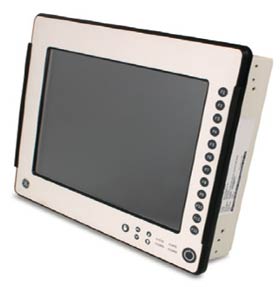|
GE Wolverine III
GE Intelligent Platforms offers rugged COM Express-based flat panel computer for harsh environments
(by Conrad H. Blickenstorfer, September 2011)
In September of 2011, GE Intelligent Platforms announced the Wolverine III Rugged Flat Panel Computer. According to GE, the new Wolverine III was designed specifically to withstand the rigors of deployment in harsh, hazardous (Hazloc) applications such as oil and gas exploration and drilling where salt, spray, dust, shock, vibration and extremes of temperature provide the most challenging environments for computers. Used for data gathering and the control or operation of sophisticated equipment, it represents a complete redesign compared with its predecessor which, with its use of GE-patented technology, delivers significantly higher performance, reliability and maintainability while weighing substantially less.

The Wolverine III has a footprint of 15.9 x 13.75 inches and is around five inches thick. It weighs about 23 pounds and is suitable for mounting in numerous panel or yoke configurations in just about any environment. The Wolverine's resistive touch display measures 15 inches diagonally and offers XGA 1024 x 768 pixel resolution. To provide sunlight readability with minimal temperature rise, the AMTFT LCD utilizes Computer Dynamics' passive enhancements including an anti-glare casting, anti-reflective coatings, IR blocking, and a transflective enhancement film. For reliable operation, an impact and scratch-resistant Acrylic-on-Glass touchscreen is standard.
The Wolverine III is powered by a 2.26GHz Intel Core 2 Duo processor with 6MB of L2 cache and a 1066MHz front side bus. The processor is soldered to provide extra vibration resistance.
The ability to run certain applications often determines the purchase decision of panel computers. To accommodate the largest variety of software possible, the Wolverine III can be configured with Windows XP, Windows 7 (and presumably their embedded versions), as well as Linux.
As far as ruggedness goes, GE Intelligent Platforms designed the Wolverine to be able to handle conditions encountered in just about any harsh environment. The device is sealed to IP65 specifications, which means it is totally sealed against dust and it can also handle low pressure jets of water from all directions. The Wolverine III is also significantly vibration-proof and can operate in an extremely wide temperature range of -4 to 140 degrees Fahrenheit. For use in very low temperatures, customers can even order a heater that lowers the operating temperature to -40F.
GE addressed the request for shortened MTTR (Mean Time To Repair) with the ATEX Zone 2 concept of user-serviceability (see Wiki entry on ATEX). That includes modular construction suitable for customer repair, minimizing downtime. On-board system monitoring allows potential failure to be identified, allowing remedial action to be taken while minimally disrupting operations. Also note that the Wolverine II is based on a COM Express module sitting on a specially designed carrier board, which means the system is scalable and largely obsolescence-proof.
COM-Express, indicentally, introduced in 2005 by the PCI Industrial Computer Manufacturers Group (PICMG), is an embedded system board standard based on serial differential signaling technology for high performance embedded computing applications that require maximum I/O bandwidth, such as imaging, industrial automation, mapping, security, aerospace, etc.
The Wolverine II generally uses vehicle power (10 to 32 VDC), but also uses auto-ranging 100-240 VAC.
For communication, there are dual Gigabit Etheret ports, four non-incendive USB 2.0 ports, four serial ports (two of them optically isolated RS232, the other two RS232/422/485), and VGA out.
For operation, the Wolverine comes either with a blank front on its touch screen, with power/clean/brightness buttons, or with those and F1-F12 function buttons, as shown in the picture above.
|









